If you know of a Columbia College student, faculty member, alumnus/alumna or program we should spotlight, or if you would like to submit a story, please contact:
Columbia College
Office of Communications
cc-comms@columbia.edu

“So if you were to ask me what class to take next semester, I would answer based on personal experience: take a class that will push you beyond your limits and encourage you to interpret the world you live in through different lenses, like Video as Inquiry quite literally did for me.” – Lauren Swerdloff CC’17
In Spring 2016, Lauren Swerdloff CC'17 was a student in Video as Inquiry, a class taught by Frances Negrón-Muntaner, professor of English and comparative literature, that was meant to familiarize students with visual production, particularly video production, as a mode of inquiry to explore a wide range of questions, including those related to race, ethnicity and indigeneity. Here, Lauren reflects on her experience in the class.
In January 2016, during the chaos of the “class shopping” period, I registered for Video as Inquiry taught by Frances Negrón-Muntaner, professor of English and comparative literature. The class was relatively new to Columbia’s campus, and the syllabus read, “As part of the course, students will produce a video and complete it by semester's end.” At first the lofty goal sounded achievable and appealing; that is, until I started researching cameras and equipment. Completely foreign to the language of filmmakers, I realized I didn’t know how to use a professional video camera or film editing software and wondered what I had just signed myself up for.
I asked Professor Negrón-Muntaner to meet with me after class and admitted my concerns to her. She didn’t directly say whether I should stay in the class or leave, but instead responded with practical advice about filmmaking, tips about cameras, script-writing, editing software and music licenses. I could feel her confidence in me and in the potential of our class – there was no turning back.
 Lauren Swerdloff CC’17 sets up her equipment for the first time. Photo: Courtesy Lauren Swerdloff CC’17
To create my script I didn’t have to look far. Throughout 2015 I had been researching and writing a nonfiction book about the history of the Hollywood Sunset Free Clinic, a non-profit center that has provided free healthcare to more than 1 million people since 1968. One volunteer in particular, Bob Suazo, always stood out to me. I hadn’t yet investigated his story, but I had vaguely heard it many times before. In the late 1980s, after serving in the Vietnam War, Bob was homeless and struggling with drug and alcohol addictions. After receiving counseling sessions at the clinic, he became a volunteer and eventually developed the clinic’s Homeless Care Program, using an RV to take medical staff and supplies to people living homeless on the streets of Los Angeles. Despite his personal challenges, he was able to serve as a source of support for thousands of people until his passing in 2008.
Lauren Swerdloff CC’17 sets up her equipment for the first time. Photo: Courtesy Lauren Swerdloff CC’17
To create my script I didn’t have to look far. Throughout 2015 I had been researching and writing a nonfiction book about the history of the Hollywood Sunset Free Clinic, a non-profit center that has provided free healthcare to more than 1 million people since 1968. One volunteer in particular, Bob Suazo, always stood out to me. I hadn’t yet investigated his story, but I had vaguely heard it many times before. In the late 1980s, after serving in the Vietnam War, Bob was homeless and struggling with drug and alcohol addictions. After receiving counseling sessions at the clinic, he became a volunteer and eventually developed the clinic’s Homeless Care Program, using an RV to take medical staff and supplies to people living homeless on the streets of Los Angeles. Despite his personal challenges, he was able to serve as a source of support for thousands of people until his passing in 2008.
I wanted to better understand this elusive man and his world. Through retracing his footsteps, I hoped to preserve his history and further the conversation about poverty and grassroots level activism. To begin the filmmaking process, I researched Bob, Skid Row (the area of Los Angeles where he and other people who were homeless lived), and the Homeless Care Program. Over spring break, I interviewed people who he once knew using camera equipment on loan from a clinic volunteer. Fortunately, the clinic also had years of old video footage from the 1990s where Bob appeared in glimpses. As I watched him day after day – the way he humbly avoided compliments, his dark sarcastic jokes, the kindness and respect he treated strangers with on the streets – his essence became more apparent to me. Striving to capture his nature in a short documentary film was like attempting to reveal the complexity of the world in one breath.
After dozens of script drafts, weeks of learning how to use editing software, and numerous all-nighters, the film came to fruition. My mom called me nervously and asked,“Are you sure you’re okay? Maybe you’re spending too much time on this.” But I was more than “okay.” Creating this film in such a time frame was close to sorcery for me. It was all consuming in the best of ways.
By the end of Spring 2016 I had finalized the film, “Suazo: The True Story of a Los Angeles Hero.” On May 5, I posted it to YouTube. Granted, it was clearly amateur, but it retained one man’s incredible story for the historical archive. Within the first few days after the release, the film received more than 500 views and nearly $450 in donations for the free clinic.
Since then, the film has continued to garner support. Classmates have asked me about the clinic and about how they can get involved in their own communities. Bob’s children and grandchildren also contacted me, sharing how this film brought back memories that made them feel as if Bob’s spirit was alive again. Producing this film gave me the opportunity to witness how one short student-made film could reach and impact individuals across the country, all while helping a clinic continue to provide free healthcare.
Through this class, my peers and I learned about the art of media as a vehicle for social change. Professor Negrón-Muntaner pushed us into the frontiers of the unexpected and reminded us that we not only had the ability to enter the realm of social inquiry and media, but that we also had the right.
In the span of one semester, Professor Negrón-Muntaner gave our class the underpinnings we needed to engage in filmmaking. She taught us the basics of production. She opened conversations about the ethics of film, the theory of film as a means to obtain knowledge and truth, and the need for experimental narratives in cinema. She introduced us to an array of films and theoretical writings ranging from Sonia Sontag to Jean Luc-Godard. Above all, she gave us the opportunity to apply everything we experienced in our readings and discussions to reality, whereby our own conceptions of society and media would be challenged and transformed.
So if you were to ask me what class to take next semester, I would answer based on personal experience: take a class that will push you beyond your limits and encourage you to interpret the world you live in through different lenses, like Video as Inquiry quite literally did for me. Any opportunity at Columbia that can remind us how to navigate comfortably alongside fear is worthwhile, because that is where our education truly takes flight. As Professor Negrón-Muntaner often says, “pa'lante.” Go forward.
Lauren Swerdloff CC’17 is a member of the Hollywood Sunset Free Clinic’s Board of Directors and is the author of Uplifting Lives. The nonfiction book features the story of clinic volunteer Bob Suazo, as seen in her documentary film, Suazo: The True Story of a Los Angeles Hero, as well as many more inspiring narratives. Proceeds from each book sold are donated to the Hollywood Sunset Free Clinic. To learn more, visit LaurenSwerdloff.com.